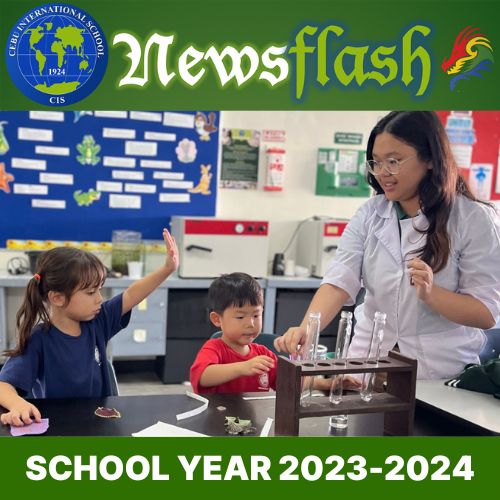
Principal’s Corner
by Ms. Maureen Juanson, Elementary School Principal
Building Resilience
In the journey of education, we often speak of preparing our students not just for academic success, but for life beyond the classroom. A huge part of this preparation is to build resilience. When faced with academic challenges, social conflicts, or personal struggles, resilience helps them navigate these difficulties, learn from them, and come back even stronger.
 Insights from educational research highlight the crucial role parents and teachers play in fostering resilience in our young learners. When students encounter obstacles or conflicts, they naturally turn to their trusted adults for guidance and support. As caring educators and parents, our immediate instinct is often to step in and alleviate their difficulties. However, this well-intentioned response, while comforting in the short term, may inadvertently hinder the development of resilience.
Insights from educational research highlight the crucial role parents and teachers play in fostering resilience in our young learners. When students encounter obstacles or conflicts, they naturally turn to their trusted adults for guidance and support. As caring educators and parents, our immediate instinct is often to step in and alleviate their difficulties. However, this well-intentioned response, while comforting in the short term, may inadvertently hinder the development of resilience.
Resilience is the capacity to bounce back from adversity, persevere in the face of challenges, and thrive despite setbacks. It is not an innate trait determined solely by genetics, but rather a skill that can be nurtured and strengthened through intentional practice and experience. It’s like a muscle – the more we use it, the stronger it gets.
At CIS, we recognize the connection between resilience and academic performance. Students who possess resilience are better equipped to manage stress, adapt to change, and persist in their learning endeavors. They demonstrate greater focus, determination, and problem-solving abilities, which are essential for success in the rigorous IB program and beyond.
As an IB World School, we are committed to cultivating resilience in our students by emphasizing the development of Approaches to Learning (ATL) skills, particularly self-management skills. Through inquiry-based learning experiences, collaborative projects, and reflective practices, students learn to set goals, manage their time effectively, organize their work, regulate their emotions, and persevere in the face of challenges.
Furthermore, we understand that building resilience is a partnership between home and school. Parents play a vital role in supporting their children’s resilience development. The American Psychological Association (APA) offers valuable guidance for promoting resilience in children.
Let’s continue to actively cultivate resilience in our students, empowering them to flourish in all aspects of their lives.
Upcoming events of note
- Mar 18 – Apr 1: IB Art Exhibition
- Mar 25 – Apr 1: Spring/Easter Break
- Apr 9: Public Holiday (Day of Valor)
- Apr 10: Public Holiday (Eid-al-Fitr)
- Apr 12: MYP Personal Project Exhibition
- Apr 18: DP TOK Exhibition
- Apr 24 – May 16: IBDP Exams
Please refer to the CIS Event Calendar for the complete calendar of school events.
Early Years: Celebration of Learning
by Ms. Ann Codoy, Early Years Teacher
Celebrating Music and Emotions!
The Early Years put on a heartwarming performance this week, culminating their unit under the transdisciplinary theme “How We Express Ourselves” with a conceptual focus on music! Parents were treated to a special showcase where their little ones sang “Little Peter Rabbit” and showcased their moves with an energetic “Roar and Handclap.” This delightful performance, a true team effort between homeroom, music, and PE classes, explored how music can influence our feelings.
But the learning didn’t stop there! The Early Years went digital, creating interactive stories using Book Creator. They showcased their artwork, written stories, and even added their own voice-overs and sound effects! This engaging project demonstrates their communication and storytelling skills in a fun way.
After the delightful stories, the fun continued with engaging station rotations. Students, alongside their proud parents, were grouped into three teams and embarked on an interactive learning adventure!
Art Station: A Masterpiece in the Making!
A hub for artistic expression, The Art Station uses music and visual arts to spark creativity. Following a unit on music where students built instruments from recycled materials, The Art Station hosted a fun, interactive LISTEN-THINK-DRAW activity for students and their families. This engaging event explored the powerful link between music and emotions, inviting participants to listen, reflect, and express themselves through the art of drawing.
Music Station: The Music Moves You!
The Early Years embarked on a musical journey in UOI and Music class! They discovered how to create music in all sorts of ways – from traditional instruments to their own bodies and even everyday objects! This station also highlighted their courage as they practiced and played a variety of instruments. Parents even joined the fun, participating in our “Music and Our Emotion” activity, where they experienced firsthand how music can influence our feelings. Using iPads, they listened to different pieces and then colored emojis that matched how the music made them feel.
Get Creative by Creating Music!
This station was a hit with parents! They dove into the world of music using Chrome Music Lab. With no prior experience needed, parents had a blast composing short songs, experimenting with sounds and rhythms, and even creating artwork inspired by their musical creations! The fun didn’t stop there – parents also explored different instruments and participated in a “sound in a bottle” experiment with their children, further deepening their understanding of sound and music.
To wrap up the celebration, parents participated in TAG Feedback (Tell- something you like, Ask- a question, and Give- a suggestion). Overwhelmingly, parents loved everything, particularly the interactive station rotations where they did activities connected to the unit. They appreciated how their child’s growth and experiences were shared. They expressed appreciation for the interactive stations and the overall experience of witnessing their child’s growth during their early years!

This celebration of learning was a fantastic display of teamwork, creativity, and the joy of early childhood education!
MYP Science
by Ms. Haydee Montero, MYP Science Teacher
Grade 6: IDU – Empowering Innovation: A Makey-Makey Journey Through Interactive Music and Beyond
The Grade 6 students eagerly delved into the world of interdisciplinary learning through a unique Integration of Disciplines Unit (IDU) in Science and Music. Armed with creativity, curiosity, and a Makey-Makey device, they embark on a journey where science meets melody, and innovation harmonizes with artistic expression.
The focal point of this innovative project lies in the creation of their chosen musical instruments from scratch, using the Makey-Makey device. The Makey-Makey is a simple circuit board that turns everyday objects into touchpads for music creation, letting students play science while making music.
Here are some thoughts of students when asked to explain what each discipline (Science & Music) has done to develop the theme of creativity and innovation or development:
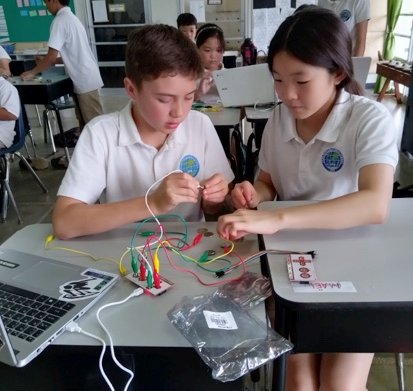
The disciplines of Music and Science helped me to improve my creativity and development in my work by helping me use Makey – Makey which gave me creative sound ideas to use for my drum. All the learnings I got from music and science also helped me understand more about how science can affect music and how music can affect science. I have also learned from the discipline to use copper for my drum instead of lead and aluminum because it affects the material’s conductivity because of the presence of many free electrons. The science discipline helped me understand the electrical circuit of the drum kit and the Makey-Makey. The discipline of music helped me understand and justify everything for my drum and created creative music and sounds for my Makey-Makey project. For my Makey-Makey project, I used all the materials copper, aluminum, cardboard, tape, glue, and Makey-Makey. I used copper for my wires so that they project the sound from scratch better than the other conductors. I used cardboard for the base of the drum and also the drum by itself, and then I used aluminum to wrap around the cardboard so that it became a conductor. I used tape to cover the outer layer of the copper so that when you touch it, it does not hurt others when touched because the tape is an insulator. The glue was to attach all the cardboard disks as the drum to the base. My Drum kit has 8 drums in it and the drums are A for Bass, W for High tom, S for Low tom, D for crash cymbal, E for snare, G for ride cymbal, up arrow for floor tom, and down arrow for high hat. The instrument worked by holding the power source and then clicking another drum.
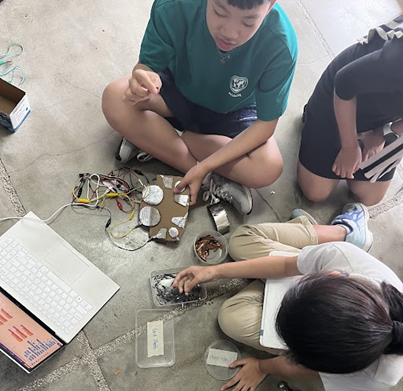
Science helped me work on this project easier. For instance, when I was struggling with the sound of the drum because the volume was too low, understanding the concept of conductivity helped me to solve the problem. Then, I changed the aluminum tape to copper. It helped me a lot because even if I set the volume of the laptop to maximum, the sound was still low. Furthermore, my knowledge of coding helped me to construct the code using scratch that sounds as if I touched something. Based on my ideas, I could make a code that can change the volume of the sound. For example, when I touch w and r together, it raises the volume. and when I touch w and f at one time, it lowers the volume of the sound. Lastly, to understand conductors and insulators, I covered again the bottom of the drum pad with new aluminum foil because my connection to the laptop was unstable. In conclusion, my understanding and knowledge of science assisted me in finishing my project on time with satisfying quality.
On the other hand, music helped me as much as science did. It helped me construct the drum by introducing me to what the instrument looks like. It gave me a chance to be creative, to play, and to find structure.
Grade 9: Every chemical reaction has a transition state
In the realm of science, the study of chemistry stands out as a captivating journey into the intricate dance of atoms and molecules. At the core of this exploration lies the concept that “every chemical reaction has a transition state,” a theme that has ignited the curiosity and creativity of Grade 9 students in their scientific inquiry, showcasing their chosen AHA-mazing scientific exploration.
Guided by the fundamental principle of the law of conservation of mass, students strive to demonstrate the unyielding balance that governs chemical reactions. Armed with a diverse array of representations and models, including words and simple balanced chemical equations, they endeavor to unravel the intricacies of molecular rearrangements.
Here are a few of the students’ AHA-MAZING Scientific Chemical Reactions:
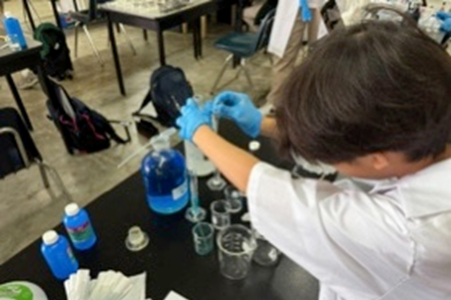
In the investigation, the reactants in the chemical equation are CuSO4 and 2NaOH (Copper sulfate and Sodium hydroxide) while the products in the study are Cu(OH)2 andNa2SO4 (Copper hydroxide and Sodium sulfate). The type of chemical reaction used in this study is double replacement/displacement as the sulfate and hydroxide elements swap places; to give more context this is how it looks like, (AB + CD → AC + BD) (CuSO4 + 2NaOH⟶ Cu(OH)2 + Na2SO4).
A balanced chemical equation always obeys the law of conservation of mass. According to this law, the mass of products must be equal to the mass of reactants. A reaction is said to be balanced when the total mass of atoms on both sides of the chemical reaction is equal.

The substances that would be considered reactants in this chemical equation: K2CO3 + CaCl2 → KCI + CaCO3 )are K2CO3 (Potassium carbonate) and CaCl2 (Calcium chloride). Additionally, when looking at the chemical equation you can identify the type of chemical reaction, which is a double-replacement since both reactants were mixed and changed to two new chemical compounds on the product side, we can also see this during the experiment, when both liquids were mixed creating both a bubbling gas and a new liquid as a product of the chemical reaction.
Grade 12: IB DP Visual Arts Exhibition
by Mr. Jessie Saclo, DP Visual Arts Teacher









This is a glimpse of this year’s IB DP Visual Arts Exhibition, the culmination of two years of hard work, inquiry and creativity, showcasing the diverse skills and achievements of students in visual arts. It is a unique opportunity for students to demonstrate their mastery of various art-making forms. The IB DP Exhibition serves as a cumulative assessment, showcasing students’ knowledge and understanding of IB principles across various disciplines. In this exhibition, viewers are exposed to art revolving around various, disciplines, themes, and issues, wrought through the process of exploration, experimentation, critical thinking, and creativity.
Visit the IB DP Exhibition, open during school hours from March 19 to April 1 in the studio.
MYP Math Class
by Mr. Daniel Monfre, MYP Math Teacher
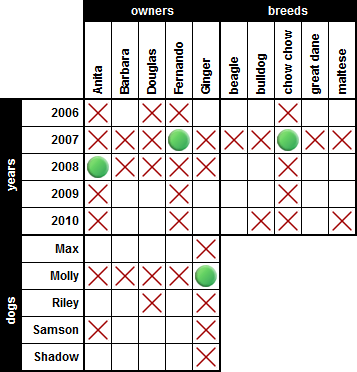 Last week was STEM Week at CIS and the school was full of activities for all students. We had students designing and flying paper planes, trivia games, puzzles, scavenger hunts, and cryptography challenges!
Last week was STEM Week at CIS and the school was full of activities for all students. We had students designing and flying paper planes, trivia games, puzzles, scavenger hunts, and cryptography challenges!
In math classes, students got to explore a variety of math games and applications. In grade 6 we investigated what logic is and how math helps us with solving problems in a logical manner. Students applied their logic skills to solve puzzles (like the one below) on Logic.PuzzleBaron.com which allows them to check their work and compare their solution times to others around the world.
 In grade 7 we took a look at the 2024 Pi Day Challenge, a webpage that publishes a different set of pi themed problems every March 14 (3-14!). We worked as a class to see how many of the puzzles we could solve together. The students solved the puzzles by applying logic, algebra, geometry, and probability. Feel free to check it out yourself at pidaychallenge.com.
In grade 7 we took a look at the 2024 Pi Day Challenge, a webpage that publishes a different set of pi themed problems every March 14 (3-14!). We worked as a class to see how many of the puzzles we could solve together. The students solved the puzzles by applying logic, algebra, geometry, and probability. Feel free to check it out yourself at pidaychallenge.com.
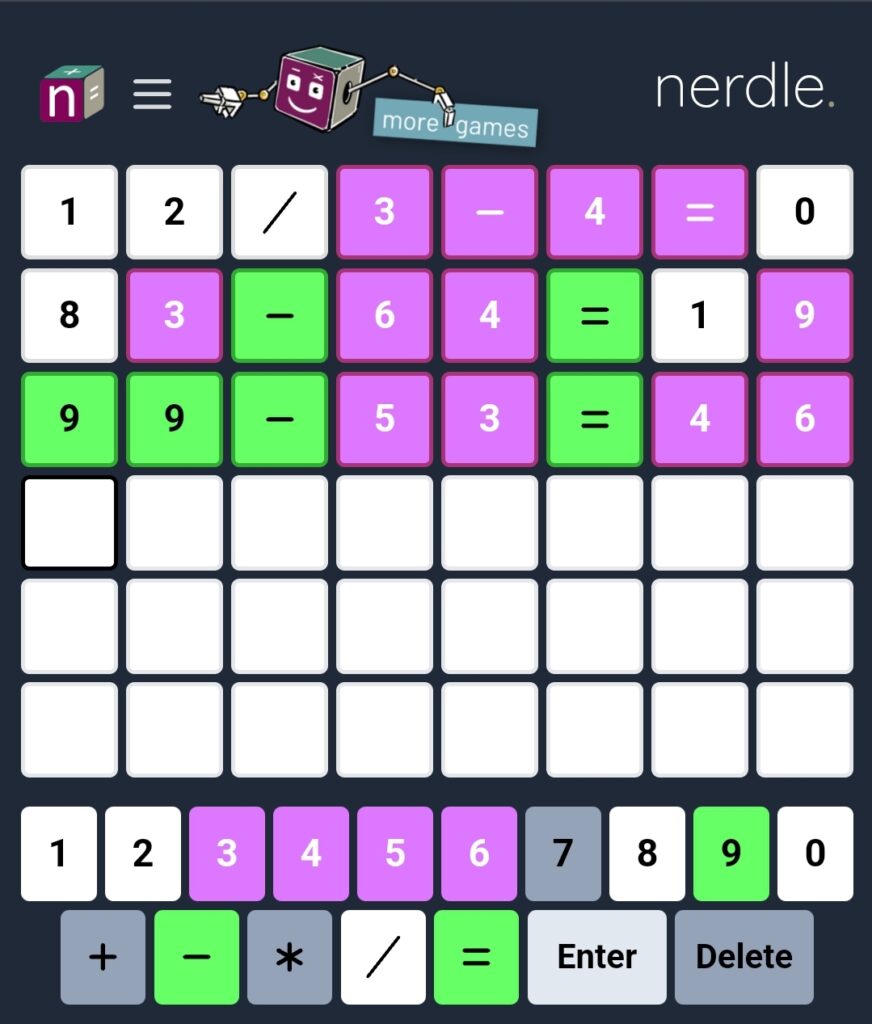 Grade 10 focused on a math-themed challenge focusing on equations and the order of operations. Similar to the game Wordle, students had a chance to play the math version called Nerdle. In Nerdle students have to come up with an equation using the digits 0 to 9 and the four basic operations. Each guess lets them know if the numbers and operations are in the correct order, the right operation in the wrong place, or not included in the equation. Through the process of elimination, they had 6 chances to guess the correct answer. Then they really put their skills to the test with the MaxiNerdle which includes exponents, brackets, and roots as part of the solution!
Grade 10 focused on a math-themed challenge focusing on equations and the order of operations. Similar to the game Wordle, students had a chance to play the math version called Nerdle. In Nerdle students have to come up with an equation using the digits 0 to 9 and the four basic operations. Each guess lets them know if the numbers and operations are in the correct order, the right operation in the wrong place, or not included in the equation. Through the process of elimination, they had 6 chances to guess the correct answer. Then they really put their skills to the test with the MaxiNerdle which includes exponents, brackets, and roots as part of the solution!
College & Careers Counselor Corner
by Ms. Jenny Basa, College Counselor
If you are wondering if the SAT will be required again for college admission, please read this article: The SAT is coming back at some colleges…

DATE
EVENT
April 18 Thursday
9:00 – 9:40 AM
Canteen Annex
All HS students invited to attend

SAT Update
2023–24 School Year Test Dates
| Test Date | Deadline for Registration, Changes and Regular Cancellation |
| May 4, 2024 | April 19, 2024 |
| June 1, 2024 | May 16, 2024 |
To register for the SAT, you may click on this link. If you need assistance or have any questions, please feel free to email Ms. Jenny Basa at jbasa@cis.edu.ph.




